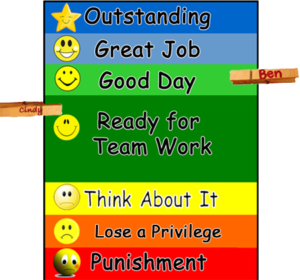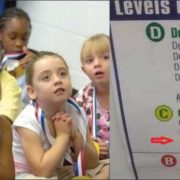How a Behavior Chart Harmed Our Daughter
There are many evidence-based reasons for concluding that those commonly used behavior management charts found in many classrooms are not helpful, healthy, and can have negative consequences. Even for children that always maintain “good” behavior, these charts can have a negative impact on their mental health. We found this out the hard way.
 Our first encounter with the colored behavior charts was public school kindergarten. Those first few days didn’t seem to bother our daughter much. Our parenting philosophy at home was based on being authentic, peaceful, and empathetic, so she was already a child that wanted to be respectful to others and manage her own behavior.
Our first encounter with the colored behavior charts was public school kindergarten. Those first few days didn’t seem to bother our daughter much. Our parenting philosophy at home was based on being authentic, peaceful, and empathetic, so she was already a child that wanted to be respectful to others and manage her own behavior.
Daily reports from the teacher showed our daughter constantly landing herself on the “good” colors green and purple. But we found it odd that when asking our daughter about her day, all she could typically remember was which child was on the “bad” colors. The behavior system seemed to be more of a distraction at that point than anything else.
As time went on, we realized it was more than a distraction. When we talked with her, we were surprised to learn how distressed she was on behalf of her fellow classmates. She noticed the impact the colored chart had on her classmates. She felt empathy for them, but helpless to do anything. She saw the injustice when certain friends were put on “bad” colors for minor infractions or false accusations made against them. She saw how reputations of children were being shaped as a result of what colors they typically landed on.
She showed signs of distress and worry that one slip-up could result in negative public judgment in front of her peers. Each day you could see the anxiety and stress building within her. The pressure to avoid getting her clip moved down became overwhelming. This was regardless of the fact that in our conversations with her, we always conveyed to her that we didn’t believe these colored charts were an appropriate tool. This didn’t seem to reduce her anxiety. It makes sense from her point-of-view; we aren’t there with her in the classroom—which is a completely different ecosystem within a rigid institution. An environment that we discovered to be authoritarian, hierarchical, inauthentic, obedience-focused, freedom-restricting, behavior-controlling, and testing obsessed. She was trying to conform to this type of system, but it was harming her mentally in order to do so.
A month into kindergarten and she was begging us to tape her mouth shut to prevent any possible slip-ups that could result in her clip being moved down.
Things were getting worse and our list of concerns grew. We talked with the teacher and administration. Most of our concerns were disregarded, or we were told that this was the policy and it couldn’t be changed.. “This is just the way things are done”, they would say. Feeling like we weren’t going to make any headway to change the behavior management policy, we began looking at alternatives.
As we were researching our alternatives and nearing a decision to homeschool, our daughter came home extremely upset. She had been “put on yellow”. Our daughter explained that she was in a “center” playing a “learning game” that was to be played a certain way when one of the four children in that center suggested they play that game differently. The idea sounded good to them, so they tried it the new way. The teacher came over and told them they were doing it wrong and to go put all their clips on yellow.
My daughter tried to defend herself: “But…”, she tried to say, but was cut off by the teacher. “No ‘buts’, go put your clip on yellow now.” She felt angry, defeated, shamed, and wrongly targeted. When she came home we could tell she was holding back tears. We felt sick after our daughter, who had never before shown any signs of emotional distress, said she felt like killing herself. A 5-yr-old child who—before starting kindergarten—was normally a cheerful, inquisitive, and affectionate was becoming depressed, disengaged, and disinterested in learning. Our child was being damaged by a system with no evidence of even being effective. This was madness.
Before we had reached this point, we had already done our research and found that there wasn’t any compelling evidence to support the use of these colored behavior charts. In fact, the evidence suggested they did more harm, than good. In conversations with other parents and educators, we were hearing about similar experiences with these charts and the detrimental effects they had seen in children. Beyond the charts, our concerns about the classroom environment expanded into other areas that were punitive. This just wasn’t the type of learning environment our daughter deserved—this was inhumane.
Without any alternative schooling options that fit our needs and desires we decided to withdraw her and begin homeschooling. That was over 3 yrs. ago. We spent a few years deschooling and trying to repair the damage done to her. Luckily, we feel like our decision was the best one we could have made and we have our cheerful, inquisitive, and affectionate child back. We have been able to create a homeschooling learning environment that allows her to express herself, socialize, be creative, be a leader, follow her interests, and best of all, be treated with dignity and respect.
—
If you would like to learn more about behavior charts and suggested alternatives, please see this document of helpful articles and resources.
By David Martin
David is the owner of Brighter Technologies and Brighter Schooling. He is a Parent, Advocate for Self-Directed Education, Entrepreneur & Life-Long Learner.




